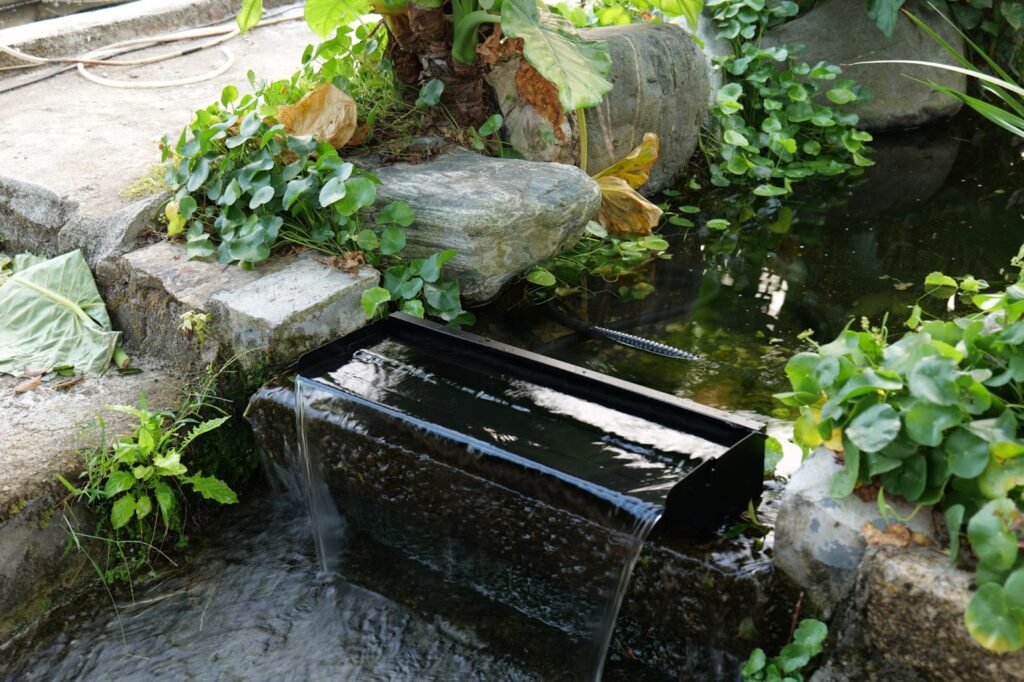Life Style
Waterfall vs. Fountain: Which Feature Fits Your Backyard Pond Best?
Published
3 weeks agoon
By
IQnewswire
A backyard pond is more than a decorative hole filled with water; it’s a living ecosystem and a focal point for relaxation, wildlife observation, and creative expression.
Two of the most popular enhancements, waterfalls and fountains, each bring their brand of magic. Yet homeowners often struggle to decide which one will best suit their goals, budget, and maintenance tolerance.
Defining the Two Features
Waterfalls generally involve water coursing over rocks or engineered ledges, creating a continuous sheet, curtain, or series of cascades. They require an elevation change, even if it’s artificially created with retaining blocks or buried barrels.
Fountains propel water upward or outward via nozzles, forming dramatic plumes, bell shapes, or gentle bubbling effects. They sit at pond level and rely on pump pressure rather than gravity.
Both rely on pumps, plumbing, and adequate power sources, but their visual signatures and engineering needs differ sharply.
Aesthetic Impact and Design Flexibility
Waterfalls read “naturalistic” even in highly manicured landscapes. Their stones, mossy crevices, and variable flow rates mimic forest streams. Fountains learn modern or formal, echoing European palace courtyards or sleek Zen reflecting pools.
During design brainstorming, remember that any waterfall or fountain benefits immensely from a well‑planned filtration system for a pond to keep the water sparkling and debris‑free.
Professional designers often use waterfalls to conceal pond edges, integrate planting pockets, or mask unattractive fencing. Fountains, meanwhile, become sculptural centerpieces that draw the eye from every direction.
Soundscapes and Sensory Experience
Waterfalls produce a deep, rolling “white noise” that muffles road traffic and urban clamor. Their acoustic range can be tuned by adjusting drop height, rock spacing, and pump speed.
Fountains offer a crisper, more percussive sound. A tiered fountain drips musically, while a geyser nozzle emits a gentle hiss punctuated by plopping droplets. Sound matters if you host outdoor meditation sessions, yoga classes, or late‑night gatherings. Choose the tone that aligns with your lifestyle.
Oxygenation and Water Quality
Both features increase surface agitation, allowing atmospheric oxygen to dissolve into the pond, vital for fish health and beneficial bacteria. Waterfalls tend to oxygenate larger volumes because they churn deeper layers. Fountains excel in shallow ornamental ponds where high plume action circulates surface water efficiently.
Energy Demand and Equipment Choices
Submersible or external pumps power the circulation. Flow rate (gallons per hour) and head height (vertical distance water must travel) dictate wattage.
Selecting the right pumps for ponds and waterfalls prevents energy waste and ensures reliable performance, whether you’re driving a 24‑inch cascade or a 6‑foot fountain jet.
Waterfalls, with their elevation needs, usually require stronger pumps. Fountains can often run on smaller, energy‑smart units equipped with variable‑speed controls.
Installation Complexity and Cost
Building a waterfall involves excavation, liner folds around vertical surfaces, and strategic rock placement to hide plumbing. Fountains are a simpler level, a base plate, an anchor, a nozzle assembly, and a connection for the tubing.
A basic DIY fountain kit may run USD 150–500, whereas even a modest waterfall can reach USD 1,000 once rocks, liners, and retaining structures are tallied. Professional labor escalates that gap further.
Yet waterfalls often look more “high‑end” and can boost property value proportionally, an ROI many homeowners gladly accept.
Wildlife and Plant Compatibility
Both features attract birds, butterflies, and beneficial insects. Waterfalls create micro‑habitats in damp crevices, ideal for moss, ferns, and trickling rivulets that amphibians love. Fountains, with their surface spray, keep water constantly moving, deterring mosquitoes while providing quick, shallow sips for songbirds.
To maximize habitat health, some pond stewards add a solar pond aerator alongside either feature, ensuring dissolved‑oxygen stability during overcast days or power outages.
Year‑Round Maintenance Demands
- Debris Management: Leaves accumulate behind the waterfall weirs, requiring weekly skimming. Fountains trap less organic matter but develop mineral scale on nozzles.
- Winterizing: In freezing regions, pumps feeding waterfalls often relocate to the deepest zone or pull indoors. Fountain assemblies may be lifted out entirely or run all winter to maintain an ice‑free opening.
- Algae Control: UV clarifiers, beneficial bacteria, and shade plants curb algal blooms regardless of feature type. Consistency beats miracle cures.
A robust filtration system for a pond reduces algae load, extends pump life, and keeps liner surfaces clear, cutting maintenance hours in half.
Environmental Footprint and Sustainability
Homeowners mindful of carbon footprints now seek renewable‑powered solutions.
- Solar Panels: Modern panels paired with efficient pumps operate mid‑size fountains during daylight hours and waterfalls on timer cycles.
- Rainwater Capture: Diverted rain barrels can top up evaporation losses.
- Native Plantings: Surrounding your pond with indigenous flora lowers fertilizer runoff, a common trigger for algae blooms.
Marrying a feature with a dedicated solar pond aerator guarantees baseline oxygenation even when the primary pump is on a sunny‑weather schedule, reducing grid reliance.

Hybrid Solutions: Best of Both Worlds?
Who says you must choose only one? Many designers combine a small, bubbling fountain bowl at the pond center with a low waterfall at the far edge. The fountain offers day‑to‑day visual excitement, while the waterfall masks distant traffic noise and boosts aeration.
A hybrid route can moderate costs: you might use a single pump plumbed to a Y‑valve, allocating 70 % flow to the waterfall and 30 % to the fountain. Just verify the pump’s maximum head height covers both routes.
Consult spec sheets carefully when sizing pumps for ponds and waterfalls in a dual‑feature setup; undersizing will yield a dribble where you expected a cascade.
Ultimately
Choosing between a waterfall and a fountain boils down to aesthetics, acoustics, installation budget, and your willingness to perform regular upkeep. Waterfalls excel at natural integration and robust oxygenation, while fountains provide sculptural flair and simplified maintenance.
You may like

Samuel Paul Giamatti: What We Know About Paul Giamatti’s Son

How to Use Paid Instagram Followers to Grow Organically in the UK Market: A Guide for 2025

Milo Sebastian Sussman: Meet Ricki Lake’s Talented and Private Son

The Weird Stuff People Keep in Safes (And Why It Makes Sense)

The Hidden Hero Above Your Ceiling: What Loft Hatches Really Do

The One Feature That Makes Flat Roofs Easier to Manage

Unlock Stunning Video Transformations with This Free AI Face Swap Tool

Glynn Daly’s Life Story: Sister of Tyne Daly, Wife of X-Files Composer

Who Is Marcia Gresham? All About Daniel Radcliffe’s Amazing Mom

Meet Maria Providencia Ferrer Murdock, Daughter of José Ferrer and Rosemary Clooney

Revolutionizing Healthcare: The Emergence of AI-Driven Analytics

How Machine Learning and AI are Redefining the Future?

Aliza Barber: Meet Lance Barber’s Wife, Age, Life, Profile, Career and Net Worth

Evelyn Melendez: Jordan Knight’s Wife Bio, Marriage, Family, Career and Net Worth

Who was Alice Marrow? Everything to Know About Ice-T’s and His Mother

Ilan Tobianah Biography: Family, Marriage, Lifestyle, Career and Net Worth

Meet Otelia Cox: The Supportive Wife of Tony Cox – A True Fairy Tale Romance

King Von’s Autopsy Report: The Truth Behind the Tragic Death

Tex9.net Business: Solve Business Problems with the Help of Tex9.net

Exploring Real Estate Market: Smart Strategies for Savvy Investors

Samuel Paul Giamatti: What We Know About Paul Giamatti’s Son

How to Use Paid Instagram Followers to Grow Organically in the UK Market: A Guide for 2025

Milo Sebastian Sussman: Meet Ricki Lake’s Talented and Private Son

The Weird Stuff People Keep in Safes (And Why It Makes Sense)

The Hidden Hero Above Your Ceiling: What Loft Hatches Really Do

The One Feature That Makes Flat Roofs Easier to Manage

Unlock Stunning Video Transformations with This Free AI Face Swap Tool

Glynn Daly’s Life Story: Sister of Tyne Daly, Wife of X-Files Composer

Who Is Marcia Gresham? All About Daniel Radcliffe’s Amazing Mom

Meet Maria Providencia Ferrer Murdock, Daughter of José Ferrer and Rosemary Clooney
Category
Trending
-

 Health2 years ago
Health2 years agoRevolutionizing Healthcare: The Emergence of AI-Driven Analytics
-

 Technology2 years ago
Technology2 years agoHow Machine Learning and AI are Redefining the Future?
-

 Celebrity1 year ago
Celebrity1 year agoAliza Barber: Meet Lance Barber’s Wife, Age, Life, Profile, Career and Net Worth
-

 Celebrity1 year ago
Celebrity1 year agoEvelyn Melendez: Jordan Knight’s Wife Bio, Marriage, Family, Career and Net Worth


